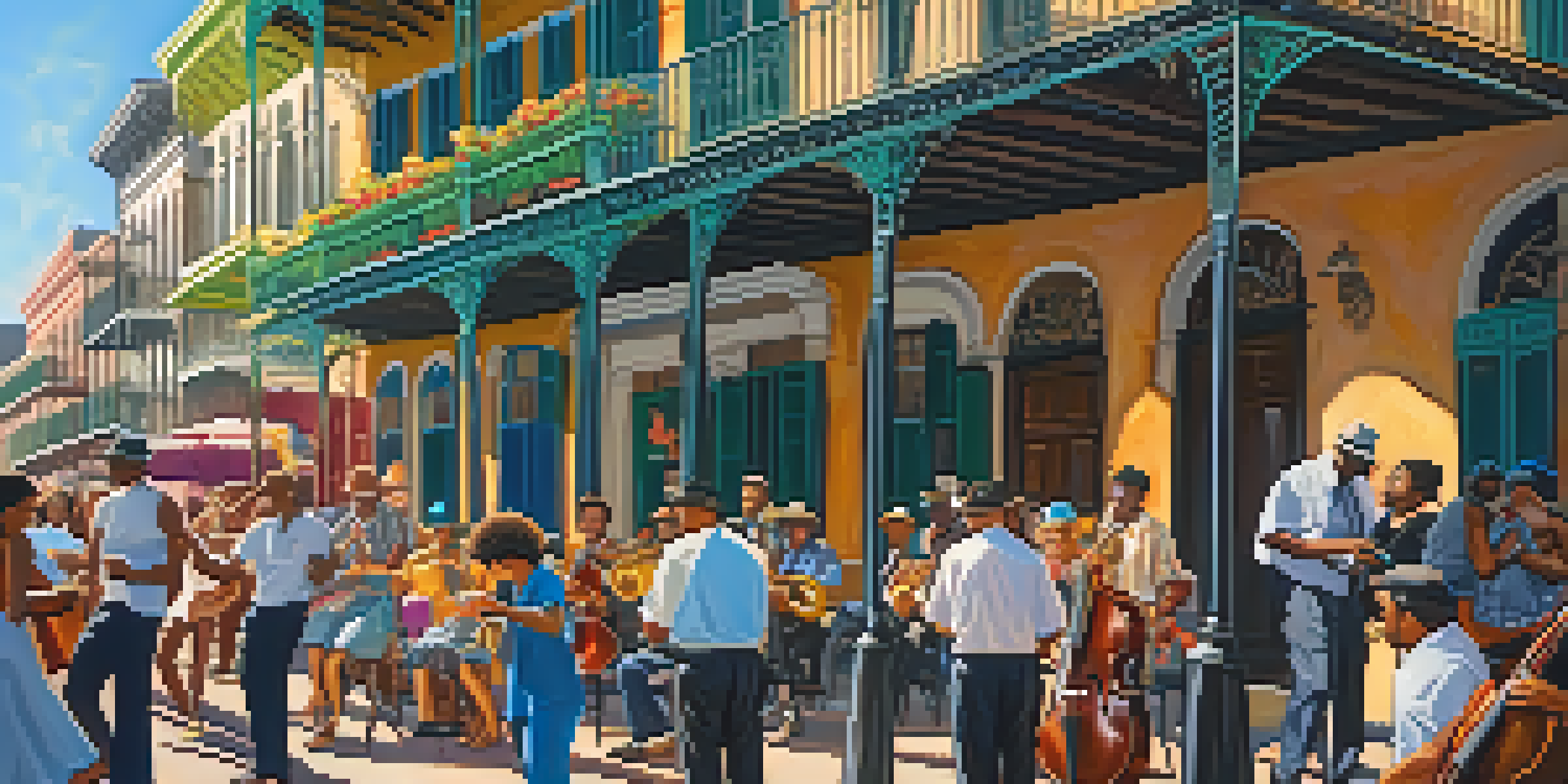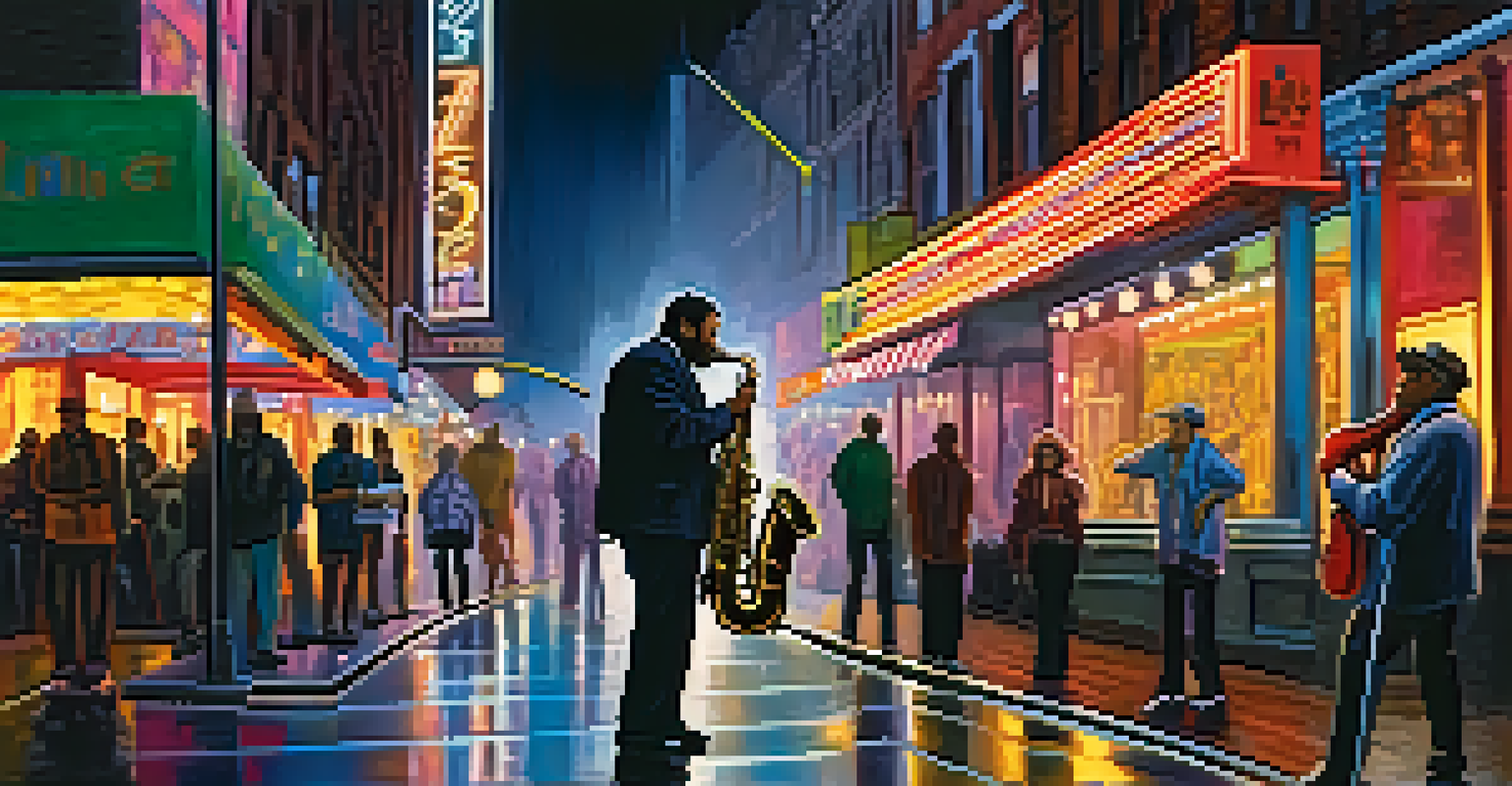The Birth of Jazz: New York City's Role in Musical Innovation

New Orleans: The Roots of Jazz Before NYC's Influence
Before we dive into New York City’s impact, it’s essential to recognize that jazz originated in New Orleans. The city’s vibrant mix of cultures, including African, European, and Caribbean influences, created a fertile ground for musical innovation. Early jazz musicians blended elements of blues, ragtime, and marching band music, giving birth to a unique sound that would eventually travel north.
Jazz is the big brother of the blues. It holds all the same feelings, but it has a different way of expressing them.
As jazz began to gain traction in the early 20th century, musicians from New Orleans started migrating to cities like Chicago and New York. This migration was driven by the search for better opportunities and a more diverse audience. With each move, these musicians brought their distinctive styles and techniques, enriching the jazz genre and paving the way for its evolution.
New York City, with its bustling nightlife and melting pot of cultures, soon became the epicenter for jazz innovation. The city’s energy and vibrancy attracted talented musicians, who sought to create something new and exciting, ultimately leading to the genre’s explosive growth.
The Harlem Renaissance: A Cultural Explosion
The Harlem Renaissance in the 1920s marked a significant turning point for African American culture, particularly in music and the arts. This cultural movement celebrated black identity and creativity, giving rise to iconic jazz clubs and venues in Harlem. Places like the Cotton Club and the Apollo Theater became hotbeds for jazz performances and talent, drawing large crowds and influential figures.

During this period, jazz musicians such as Duke Ellington, Louis Armstrong, and Billie Holiday emerged as key players in the scene. Their innovative approaches and unique styles not only defined jazz music but also contributed to its acceptance in mainstream culture. The Harlem Renaissance provided a platform for these artists to showcase their talent and reshape the musical landscape.
Jazz Originated in New Orleans
The unique blend of cultures in New Orleans laid the foundation for jazz, which evolved as musicians migrated to larger cities seeking new opportunities.
Moreover, the Harlem Renaissance helped to elevate jazz from a regional genre to a national phenomenon. It fostered a sense of pride and ownership among black musicians, empowering them to push creative boundaries and express their experiences through music.
Jazz Clubs: NYC's Thriving Music Scene
The jazz club scene in New York City flourished throughout the 20th century, providing a stage for both established and emerging artists. Venues like Birdland and The Village Vanguard became synonymous with jazz, hosting legendary performances that left an indelible mark on the genre. These clubs offered musicians a place to experiment and connect with audiences, fostering creativity and collaboration.
The thing to love about jazz is that it’s not a static form. It’s alive and it keeps evolving.
As the jazz scene grew, so did its diversity. Musicians began to explore various styles, from bebop to cool jazz, each contributing to the genre's rich tapestry. This evolution was partly driven by the vibrant club culture, where different influences collided, inspiring artists to break away from traditional norms and explore new sounds.
Additionally, these clubs served as cultural hubs that attracted musicians from all walks of life. The shared passion for jazz created a sense of community and camaraderie among artists, solidifying New York City’s reputation as the heartbeat of jazz innovation.
The Influence of Technology on Jazz
The evolution of technology played a crucial role in shaping the jazz landscape in New York City. The introduction of radio and recording technologies in the 1920s allowed jazz music to reach a broader audience beyond the confines of local clubs. This newfound accessibility helped popularize jazz and introduced it to listeners around the country, creating a demand for more innovative sounds.
As jazz musicians began to record their music, they were able to experiment with different techniques and styles. The ability to capture live performances meant that artists could refine their craft and share their interpretations with a wider audience. This technological advancement not only preserved the music but also encouraged musicians to push their creative limits.
Harlem Renaissance Boosted Jazz
The Harlem Renaissance was a pivotal moment for jazz, fostering a vibrant cultural scene where iconic artists emerged and reshaped the genre.
Moreover, the rise of television in the mid-20th century provided another platform for jazz artists to showcase their talents. Iconic performances on shows like 'The Ed Sullivan Show' and 'The Tonight Show' introduced jazz to new generations and solidified its place in American culture.
The Role of Women in Jazz Evolution
While the jazz scene was predominantly male-dominated, women played a significant role in its evolution, especially in New York City. Artists like Billie Holiday, Ella Fitzgerald, and Sarah Vaughan not only contributed to the genre but also broke barriers in a male-centric industry. Their powerful voices and unique styles helped shape the sound of jazz, inspiring countless musicians who followed.
Women in jazz also pioneered new styles and approaches, challenging traditional norms. For instance, having a strong improvisational presence was often seen as a male trait, yet many female artists excelled in this area, proving that talent knows no gender. Their contributions expanded the boundaries of jazz and paved the way for future generations of female musicians.
Furthermore, the rise of female jazz bands in the 1930s and 1940s showcased the talent and creativity of women in the music industry. These bands not only provided opportunities for female musicians but also challenged societal perceptions about women's roles in music and performance.
The Global Influence of NYC Jazz
New York City’s jazz scene has not only shaped American music but also influenced global musical landscapes. As jazz spread beyond the United States, it inspired artists around the world to incorporate its elements into their own musical traditions. This cross-cultural exchange helped to create a rich tapestry of sounds that blended jazz with local influences, resulting in unique genres like bossa nova in Brazil and Afrobeat in Nigeria.
Moreover, international jazz festivals and collaborations have further solidified New York City’s reputation as a global jazz hub. Musicians from different countries flock to the city to learn, collaborate, and perform, creating a vibrant melting pot of styles and sounds. This exchange of ideas and influences continues to enrich the jazz genre and expand its reach.
NYC's Global Jazz Influence
New York City's jazz scene has not only influenced American music but also inspired global genres through cultural exchange and collaboration.
The legacy of New York City’s jazz scene is evident today, as contemporary artists draw inspiration from the city’s rich history. The innovative spirit of past musicians lives on, encouraging new generations to experiment and create, ensuring that jazz remains a dynamic and evolving art form.
The Future of Jazz: NYC's Ongoing Impact
As we look to the future, New York City remains a vital force in the evolution of jazz music. The city’s ongoing commitment to nurturing talent and fostering creativity ensures that jazz will continue to thrive. Emerging artists are finding new ways to interpret and innovate, blending jazz with elements from other genres such as hip-hop, electronic, and world music.
Moreover, educational institutions in New York City, such as The Juilliard School and Berklee College of Music, are training the next generation of jazz musicians. These programs emphasize the importance of both tradition and innovation, equipping students with the skills necessary to navigate the ever-changing musical landscape. This investment in education is crucial for the preservation and evolution of jazz.

The future of jazz in New York City is bright, as the city continues to be a beacon for creativity and collaboration. With each new artist, the genre evolves, keeping the spirit of innovation alive and ensuring that jazz remains a vital part of the musical tapestry for years to come.